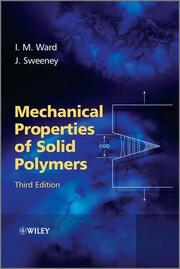-
Zusatztext
-
Providing an updated and comprehensive account of the properties of solid polymers, the book covers all aspects of mechanical behaviour. This includes finite elastic behavior, linear viscoelasticity and mechanical relaxations, mechanical anisotropy, non-linear viscoelasicity, yield behavior and fracture. New to this edition is coverage of polymer nanocomposites, and molecular interpretations of yield, e.g. Bowden, Young, and Argon. The book begins by focusing on the structure of polymers, including their chemical composition and physical structure. It goes on to discuss the mechanical properties and behaviour of polymers, the statistical molecular theories of the rubber-like state and describes aspects of linear viscoelastic behaviour, its measurement, and experimental studies. Later chapters cover composites and experimental behaviour, relaxation transitions, stress and yielding. The book concludes with a discussion of breaking phenomena.
-
-
Kurztext
-
When assessing the mechanical properties of a polymer, questions of ductility, strength and flexibility are paramount. Understanding how a polymer behaves under stress is critical to selecting the correct polymer for any given application. In Mechanical Properties of Solid Polymers 3e, the approach is to provide a formal description of the behaviour using the mathematical techniques of solid mechanics, followed by interpretations in terms of the molecular structure and morphology. The third edition combines the best qualities of its highly successful predecessors and includes: * Finite strain and rubber-like elasticity * Linear viscoelasticity and mechanical relaxation * Anisotropic mechanical behaviour * Polymer composites and nanocomposites * Nonlinear viscoelasticity * Yield, instability, and breaking phenomena Drawing on more than thirty years of teaching and research experience, Ward and Sweeney present all aspects of mechanical behaviour in an accessible way without compromising the in-depth treatments of foundational techniques and theories. The result is a straightforward, rigorous and practical guide. "Introduces the mechanical properties of solid polymers in a straightforward, rigorous, and practical manner. an essential volume for students and scholars of physics, chemistry and chemical engineering, as well as polymer researchers, chemists, and chemical engineers or material scientists in government and industry."--Professor F. J. Baltá-Calleja (Inst. Estructura de la Materia, CSIC, Spain)
-
-
Autorenportrait
- InhaltsangabePreface xiii 1 Structure of Polymers 1 1.1 Chemical Composition 1 1.2 Physical Structure 9 2 The Mechanical Properties of Polymers: General Considerations 19 2.1 Objectives 19 2.2 The Different Types of Mechanical Behaviour 19 2.3 The Elastic Solid and the Behaviour of Polymers 21 2.4 Stress and Strain 22 2.5 The Generalised Hooke's Law 26 3 The Behaviour in the Rubber-Like State: Finite Strain Elasticity 31 3.1 The Generalised Definition of Strain 31 3.2 The Stress Tensor 43 3.3 The Stress-Strain Relationships 44 3.4 The Use of a Strain Energy Function 47 4 RubberLike Elasticity 61 4.1 General Features of Rubber-Like Behaviour 61 4.2 The Thermodynamics of Deformation 62 4.3 The Statistical Theory 65 4.4 Modifications of Simple Molecular Theory 72 4.5 The Internal Energy Contribution to Rubber Elasticity 80 4.6 Conclusions 83 5 Linear Viscoelastic Behaviour 87 5.1 Viscoelasticity as a Phenomenon 87 5.2 Mathematical Representation of Linear Viscoelasticity 92 5.3 Dynamical Mechanical Measurements: The Complex Modulus and Complex Compliance 103 5.4 The Relationships between the Complex Moduli and the Stress Relaxation Modulus 109 5.5 The Relaxation Strength 114 6 The Measurement of Viscoelastic Behaviour 119 6.1 Creep and Stress Relaxation 119 6.2 Dynamic Mechanical Measurements 123 6.3 WavePropagation Methods 127 7 Experimental Studies of Linear Viscoelastic Behaviour as a Function of Frequency and Temperature: Time-Temperature Equivalence 135 7.1 General Introduction 135 7.2 TimeTemperature Equivalence and Superposition 140 7.3 Transition State Theories 143 7.4 The TimeTemperature Equivalence of the Glass Transition Viscoelastic Behaviour in Amorphous Polymers and the Williams, Landel and Ferry (WLF) Equation 147 7.5 Normal Mode Theories Based on Motion of Isolated Flexible Chains 156 7.6 The Dynamics of Highly Entangled Polymers 160 8 Anisotropic Mechanical Behaviour 167 8.1 The Description of Anisotropic Mechanical Behaviour 167 8.2 Mechanical Anisotropy in Polymers 168 8.3 Measurement of Elastic Constants 171 8.4 Experimental Studies of Mechanical Anisotropy in Oriented Polymers 185 8.5 Interpretation of Mechanical Anisotropy: General Considerations 192 8.6 Experimental Studies of Anisotropic Mechanical Behaviour and Their Interpretation 198 8.7 The Aggregate Model for Chain-Extended Polyethylene and Liquid Crystalline Polymers 212 8.8 Auxetic Materials: Negative Poisson's Ratio 216 9 Polymer Composites: Macroscale and Microscale 227 9.1 Composites: A General Introduction 227 9.2 Mechanical Anisotropy of Polymer Composites 228 9.3 Short Fibre Composites 233 9.4 Nanocomposites 238 9.5 Takayanagi Models for Semi-Crystalline Polymers 241 9.6 UltraHighModulus Polyethylene 250 9.7 Conclusions 255 10 Relaxation Transitions: Experimental Behaviour and Molecular Interpretation 261 10.1 Amorphous Polymers: An Introduction 261 10.2 Factors Affecting the Glass Transition in Amorphous Polymers 263 10.3 Relaxation Transitions in Crystalline Polymers 269 10.4 Conclusions 282 11 Nonlinear Viscoelastic Behaviour 285 11.1 The Engineering Approach 286 11.2 The Rheological Approach 289 11.3 Creep and Stress Relaxation as Thermally Activated Processes 306 11.4 Multiaxial Deformation: ThreeDimensional Nonlinear Viscoelasticity 313 12 Yielding and Instability in Polymers 319 12.1 Discussion of the Load-Elongation Curves in Tensile Testing 320 12.2 Ideal Plastic Behaviour 327 12.3 Historical Development of Understanding of the Yield Process 335 12.4 Experimental Evidence for Yield Criteria in Polymers 338 12.5 The Molecular Interpretations of Yield 342 12.6 ColdDrawing, Strain Hardening and the True StressStrain Curve 359 12.7 Shear Bands 366 12.8 Physical Considerations Behind Viscoplastic Modelling 369 12.9 Shap
Detailansicht
Mechanical Properties of Solid Polymers
ISBN/EAN: 9781444319507
Umbreit-Nr.: 3506125
Sprache:
Englisch
Umfang: 476 S.
Format in cm: 2.8 x 25.2 x 17.6
Einband:
gebundenes Buch
Erschienen am 16.11.2012
Auflage: 3/2012


